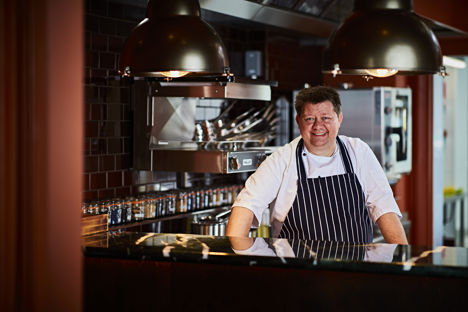
Celebrating Scotland's finest produce on Burns Night
Marked across the world, Burns Night honours the life and poetry of Scotland's Robert Burns. Chef Mark Greenaway explains why it is so important for the supper to also be a celebration of the country's world class natural larder.
Celebrating Scotland's finest produce on Burns Night
Marked across the world, Burns Night honours the life and poetry of Scotland's Robert Burns. Chef Mark Greenaway explains why it is so important for the supper to also be a celebration of the country's world class natural larder.
While the recipes may differ from home to home, most Burns Nights banquets will have much in common: A hearty soup to start, before a centrepiece of haggis, served with lashings of whisky cream sauce (and, for that matter, whisky) and neeps and tatties, finished with sweet spoonfuls of cranachan or clootie dumpling. Marked on 25 January, the occasion has recognised the life of poet Robert, or Rabbie, Burns, one of Scotland’s most important national heroes, since he died in 1796, but over the decades it has grown to become a celebration of all things Scottish.
For chef Mark Greenaway, Burns Night is also the perfect opportunity to showcase Scotland’s culinary clout. It’s fair to say the country’s cooking hasn’t always had the best reputation, but in the last decade the tired stereotypes of deep-fried Mars bars have been dismantled by chefs who are celebrating Scotland’s world class produce in modern dishes, representing the cuisine both north and south of the border. In 2016, Mark – who runs Mark Greenaway at the Haweswater Hotel and Brasserie 37 in the Lake District, Pivot in Covent Garden and Grazing by Mark Greenaway in Edinburgh – published his now-award-winning cookbook Perceptions to explore modern Scottish cuisine and shine a spotlight on its producers. ‘Any reason that we as Scottish chefs can use local produce has got to be a good thing,’ Mark agrees. ‘For so many years Scottish food did have a bad reputation, but some of the best produce comes from Scotland – whether that’s the scallops, lobster, beef or lamb. Any chance to celebrate it is also a chance to promote it.’
Burns Night, then, is the ideal occasion to do just that. When it comes to the starter, Mark recommends cullen skink, a creamy Scottish chowder-like smoked haddock soup named after the town in which it was first made – bonus points if you whip up a batch of bannocks, oat-based flatbreads cooked on a griddle, to go with it. ‘It is really hearty and warming, so it’s good for the time of year,’ Mark explains. ‘It celebrates what’s great about Scotland.’ Alternatively, he suggests a Scotch broth, made with Scottish lamb – try using neck or knuckle to guarantee a rich flavour and tender meat after a long, slow cook. Or, why not simmer chicken and leeks for a steaming bowl of cock-a-leekie soup?
When it comes to the main course, Mark agrees that it has to be haggis. The ancient origins of the dish, which is made of oats, spices and sheep offal encased in stomach lining, remain unclear; 15th century recipes mention a haggis, or haggas, pudding. Some believe its name is derived from the Icelandic ‘hoggva’, which means to hack or chop, the French ‘hachis’ or Anglo-Saxon ‘haecan’, which share similar meanings. However it came to be, it remains Scotland’s most famous dish. While you can pick one up from one of the many Scottish producers, why not have a go at Danny Kingston’s recipe for a home-made haggis – serve it, as tradition goes, with mashed swede (known as neeps) and potatoes (tatties) and finish it with a rich whisky cream sauce.
If you're looking for a fresh take on the traditional meat pudding, you're unlikely to struggle for inspiration – aside from the quality vegetarian versions which are now available (see Graham Campbell's recipe here), there are crispy haggis bon bons or Scotch eggs for bite-sized alternatives, haggis toasties for more casual dinners and Adam Handling's lamb and haggis Wellington for a Burns Night showstopper with a difference. At Pivot, Mark serves lamb haggis cooked inside a Roscoff onion, served with potato purée. ‘People are often surprised by how delicate the haggis is,’ he says. ‘We’ve had people who’ve said they wouldn’t normally eat haggis really enjoy it.’ On a trip to America, Mark also created a spaghetti bolognese using haggis and lamb mince, putting turnip and potato through a spiraliser to create the spaghetti.
It's time for dessert. Mark recommends clootie dumpling, a traditional steamed pudding made with dried fruits and spices, served with custard or ice cream – but warns that its sweet, dense nature means a little goes a long way. Alternatively, layer Scottish raspberries with a heather honey and whisky-flavoured cream and toasted oats for a cranachan, or, for those without a sweet tooth, let a Scottish cheeseboard with oatcakes round off your Burns Night supper.
We can't forget about the Burns Night staple, a dram of whisky – there are plenty of Scotch varieties to choose from, but single malt options are the most traditional. And, of course, it isn't just for sipping neat by the fire – why not experiment with whisky cocktails or make Graham Campbell's Laphroaig whisky-cured Scottish salmon for a starter which will get your Burns Night menu off to a triumphant start.
And if you aren't enamoured with haggis or are keen to branch out from tradition, there is no lack of ways to make sure Scottish produce has pride of place on Burns Night. Try Phil Carnegie's fillet of Scottish beef, Paul Welburn's pine-scented grouse (with a haggis, neeps and tatties croquette), Matthew Tomkinson's spiced Scottish scallops or Mark Kempson's steamed Scottish sea kale. From black pudding to wild salmon and beef to lobster, Scotland's rich natural larder will inspire a Burns Night to remember.


